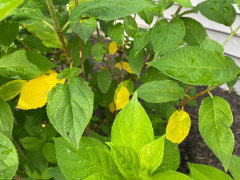An Unbiased View of Hydrangea Leaves Turning Yellow
Not known Incorrect Statements About Hydrangea Leaves Turning Yellow
Table of ContentsThe smart Trick of Hydrangea Leaves Turning Yellow That Nobody is DiscussingThe Facts About Hydrangea Leaves Turning Yellow UncoveredSome Known Questions About Hydrangea Leaves Turning Yellow.The Ultimate Guide To Hydrangea Leaves Turning Yellow
Large leaves commonly look saggy during the mid-day warm. When they fall short to perk up in the night or still look wilted in the early morning, your plant can be overwatered.Remove the plant from the dirt and prune out any origins that aren't white and turgid (plump). Replant in a brand-new place or work some sand into the dirt for far better drainage.
Include a little distilled water, stir the active ingredients, and drain pipes the extra water. Place a p, H testing strip in and await a reading. You can make use of an cost-effective moisture and ph screening meter which will certainly also come in helpful later when you wish to check your plant for underwatering and overwatering.
The very best means to do that is with dirt changes. Sphagnum moss or peat moss stops the soil from condensing and betters dirt water drainage while also increasing the dirt's level of acidity. You can scatter sulfur chips in your hydrangea soil also. Nonetheless, the most convenient way is to merely use a fertilizer that aids maintain the proper level of acidity in the soil while also feeding the plant.
The Single Strategy To Use For Hydrangea Leaves Turning Yellow
This is one good factor to repot houseplants frequently (though there are others, such as origin advancement as an example). It is additionally why houseplants call for a much stricter fertilizing regular than most outside plants. When a hydrangea houseplant is deficient in nutrients, its fallen leaves will certainly be the initial to reveal the indications.

You will additionally require to feed the plant manually and routine periods. When springtime starts in March, it's the active growing period for many houseplants, consisting of hydrangeas.
The dripline is the area located under the vegetation that is the furthest far from the facility of the plant. So instead of using feed to the facility of the plant it is best to focus it mostly in the outer areas of the pot. If you prefer to utilize a slow-release plant food such as granular or spike plant food, after that cover either kind with some dirt after you place them.
Our Hydrangea Leaves Turning Yellow Ideas

Although the hydrangea is surprisingly frost-resistant, when temperatures begin entering the 20s, the plant remains in severe danger. If the temps are in the reduced 10s, that danger is more extreme still. Clearly this is even more of a worry about outside plants so if you keep potted hydrangea outside you need to bring them inside in very check out here cool weather condition problems or also consider moving them inside throughout of the winter months.

A dehydrated hydrangea, A large issue with numerous houseplants is root rot. Root rot takes place when you overwater a plant and since it is such a common problem (especially with succulents) many houseplant proprietors are fearful of overwatering their plants. Nevertheless, hydrangeas need even more watering that a lot of various other typical houseplants and can end up being dehydrated when they are underwatered (Hydrangea Leaves Turning Yellow).
Fascination About Hydrangea Leaves Turning Yellow
Be absolutely sure that your hydrangea is dehydrated due to a lack of water and not due to it be given also much water (a lot more on this later). Overwatering is a major issue if you skimp on its water needs even a little bit, your hydrangea will certainly be quick to reveal it.
The very best means to figure out if your hydrangea is underwater is to examine the moisture degrees in the dirt. By utilizing a reliable yet low-cost moisture and p, H tester, or by sticking your finger right into the dirt, you will quickly tell if the plant requires water. To get your hydrangea watering behaviors on the ideal track, you need to be conscious concerning the moisture degrees in its dirt.
When you eliminate your finger from wet soil it will have percentages of dirt deposit stayed with it. Dry dirt will certainly indicate your finger appears clean or you can try this out with dry dirt that is conveniently blown away. If it's damp, and the plant has yellow fallen leaves after that the plant has likely been overwatered and you will certainly need to adhere to the suggestions given up the section below.